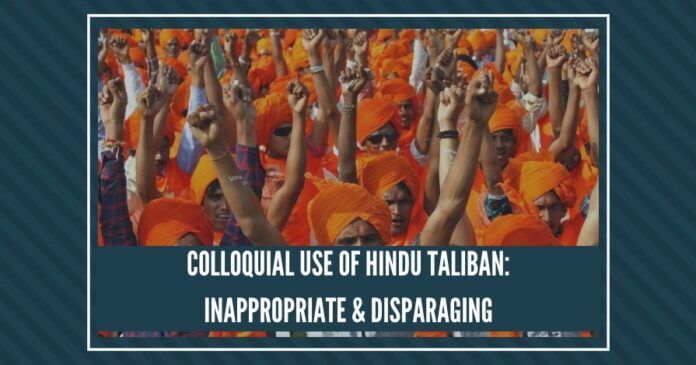
The aim of this piece is not to shout down the term “Hindu Taliban” but to try to critically understand it and counter the very lexicon and the narrative as illogical and unsubstantiated.
The left-liberal ecosystem of Indian intellectualism which loathes in masquerading itself as unbiased harbingers of social realities and postmodernist Indian society is busy in churning new lexicons to describe the modern and assertive Hindu society which is increasing by leaps and bounds. Intolerant society, Lynchian, Fascist, Militant, Communal, Manuwadi, Vigilantes if these weren’t terms enough to portray the post-2014 India society our ecosystem has more inventions like Hindu Taliban and Hindu Pakistan. Even for a country like Pakistan to get Islamized, it took 11 long years(1977-1988) under the leadership and martial rule of Zia Ul Haq. Following Zia Ul Haq’s regime, more waves of Islamization followed which have today brought Pakistan to a point of no return. But it is pertinent to note that mainstream editorials and media are successful in achieving the Islamization (read Talibanization, Fundamentalism) in a period of just four years. More than reflecting the social reality the media is busy in optics. Narratives are based on facts but in the mainstream media, it is the other way round. Given the stranglehold and one-upmanship of a few controlling the narrative, Goebbels law becomes more realistic. Narratives and perspectives need to be challenged. Labelling of a person, society or community should not be left unchallenged in a world where views are assumed to be facts. Once a label sticks it is very hard to erase it. Moreover, any attempt to challenge a narrative or erase a label would amount to altering with the facts (which, in the actual case is only challenging the narrative). Thus, it becomes very important to attack and take down (literally) these new lexicons which have entered the post-2014 Indian society.
The logic provided by Sr. Adv. Rajeev Dhawan in coining this word is that the Babri mosque was destroyed by Karsevaks on 6th December 1992.
False equivalence is not new. Equating any law with Nazism and Fascism is also not new. What is novel is the ease with which colloquial words such as Hindu Taliban and Hindu Pakistan are being pushed unabashedly in the mainstream narrative. One thing which needs to be clarified at the outset is the fact that to malign Hindu society or Hindu religion (read Dharma) it is very necessary to import words from antagonistic religions. Thus, the void of disparaging vocabulary is successfully filled by the importation of terms from foreign societies and religions. It shows the inherent resilience and acceptance of Hindu religion coupled with lack of antagonism towards other religions.
Noted senior advocate Rajeev Dhawan is to be acknowledged for giving us the term “Hindu Taliban” which raised a storm and was met with equal vocal resistance but no logical or nuanced exposition. The aim of this piece is not to shout down the term “Hindu Taliban” but to try to critically understand it and counter the very lexicon and the narrative as illogical and unsubstantiated. Charging people with blasphemy or heresy is not the intent here but to charge the narrative as manufactured surely is.
Taliban is an Islamic political movement with an aim of establishing control over the whole of Afghanistan. It is waging jihad or holy war against the state of Afghanistan. The word “Taliban” comes from the Arabic “Talib” which means a student studying or undertaking knowledge in the Islamic holy scriptures. Taliban is the plural form associated with Talib. The flag of Taliban consists of the Shahada which declares that “There is no God but Allah and Mohammad is his Prophet”. Thus, the Taliban is essentially connected to Islam. However, there needs to be at least an iota of sense to import this word and juxtapose it with the word “Hindu”. The logic provided by Sr. Adv. Rajeev Dhawan in coining this word is that the Babri mosque was destroyed by Karsevaks on 6th December 1992. This act according to him satisfies the condition of coining the word “Hindu Taliban” and justifying it as the act of demolition of Babri Mosque is similar to the destruction of Bamiyan Buddhas by the Taliban.
Hagia Sophia was restored as a museum. Parthenon was restored by the Greeks. However, the Ram Janmabhoomi lies in a pitiful state.
Now, as the intent of the writer in framing the word is clear let us compare the two incidents of destruction. Firstly, the Bamiyan Buddha statues are a cultural heritage and protected monuments. They have enormous cultural value as representing the Gandhara Art style of architecture. Secondly, it is not just a cultural heritage but has enormous historical significance as it portrays the Hindu and Buddhist history in now Islamic Afghanistan. The destruction of the Bamiyan Buddhas is akin to destroying and erasing the history. Iconoclasm is not new to Islam as thousands of temples and heritage structures were destroyed in India in the medieval period. Prominent among them is the destruction of Vijayanagara, Martanda Sun Temple, Krishna Janmabhoomi in Mathura, Somnath temple in Gujarat. The list is unending. The aim is not to display animosity and exact vengeance but to dispel historic amnesia which has gripped India. However, Islamic iconoclasm was not just rampant in India but throughout the world. The scenic and most famous Hagia Sophia Mosque was originally the Greek Orthodox Cathedral which was converted into a mosque. Hagia Sophia is one of the most iconic monuments in the world and adores the Turkish skies. One more iconic, historic and marvellous piece of architecture which was converted into a mosque is the Parthenon temple dedicated to the Goddess Athena. Thus, any non-Islamic prominent architectural marvel was either destroyed or converted into a mosque to proclaim the superiority of the conqueror and shame the conquered. If this was not enough the destruction of such architectures were worn with pride on one’s sleeves. Sikandar Shah Miri, the Butcher of Kashmir took on the title of Butshikhan (meaning iconoclast). The destruction of religious structures was to be looked upon and not to be frowned upon. The Bamiyan Buddhas were moreover disgraced fervently by spraying bullets before destroying them with dynamites. Modern weaponry like anti-tank mines and a rocket were fired to destroy the Buddhas. Moreover, just like Sikandar Butshikhan, the Talibani Mullah Mohammad Omar stated that Muslims should be proud of smashing such idols. There is so much violence that literal depiction cannot do justice to it.
Now, let us come to the destruction of the Babri Mosque. Babri is not an architectural marvel or historical monument or a heritage structure. It is proved beyond reasonable doubt that it was built upon the ruins of Ram Janmabhoomi. Thus, the false equivalence is manifest as the Bamiyan Buddha was at the receiving end and so was Ram Janmabhoomi. Babri does not have any importance in Islamic faith or practice as it is not a pilgrimage site. Kar Sewaks who destroyed Babri were not fervently backed by the Government as is the case with Taliban. There was no political movement like the Taliban to overthrow the state. There never was and never will be any legal or state sanction to its destruction as is the case with the Taliban. Babri was demolished after a sustained struggle to restore Ram Janmabhoomi and the lackadaisical attitude of the government was followed by the destruction of the mosque. Bamiyan Buddhas stand restored today but not the Ram Janmabhoomi. The movement or Andolan for Ram Janmabhoomi was for not just reclaiming religious rights to worship at the pilgrimage site but also to restore national respect and pride. Prevalence of injustice is antithetical to justice. Hagia Sophia was restored as a museum. Parthenon was restored by the Greeks. However, the Ram Janmabhoomi lies in a pitiful state. Dismay and discontent are prevalent everywhere.
Letting this disparaging term Hindu Taliban acquiesce will put us on the same pedestal and at par with the people at the hands of whom we suffered historical wrongs and injustice.
So, in all fairness can the demolition of Babri mosque be equated with the destruction of Bamiyan Buddhas? Can a movement for restoration of a historical site which was destroyed by inimical invaders be equated with a movement for a foundation of a theocratic state leading to the destruction of minority religion’s monuments? The real Talibani attitude lies not in the destruction of Babri as however gruesome the act as it was not sanctioned by the State, unlike the Taliban. The real Talibani attitude lies in the secularization by the intellectual ecosystem of the wanton destruction of Hindu religious monuments in India by invaders (politically correct)/ Muslims. Destruction of Babri was the exception, not the rule. For the Taliban, it is the other way round.
Even though the judiciary viewed the use of the term Hindu Taliban as inappropriate, votaries of the term continue using it. In the light of such use and popularization of the lexicon, it becomes imperative to challenge it. For the import of Taliban in Hindu society is very destructive. The term can have a long-lasting impression in historical studies and in narrating our civilization. Hindu Taliban and Hindu Pakistan may be political gimmicks or rhetorical oratory but to leave them unchallenged will set a dangerous precedent. Acquiescence is a bar to claiming remedies. Letting this disparaging term Hindu Taliban acquiesce will put us on the same pedestal and at par with the people at the hands of whom we suffered historical wrongs and injustice. To put it legally the colloquial use is unjust, unfair and arbitrary.
Note:
1. The views expressed here are those of the author and do not necessarily represent or reflect the views of PGurus.
- Colloquial Use of Hindu Taliban: Inappropriate at Best and Disparaging at Worst. - November 30, 2018








